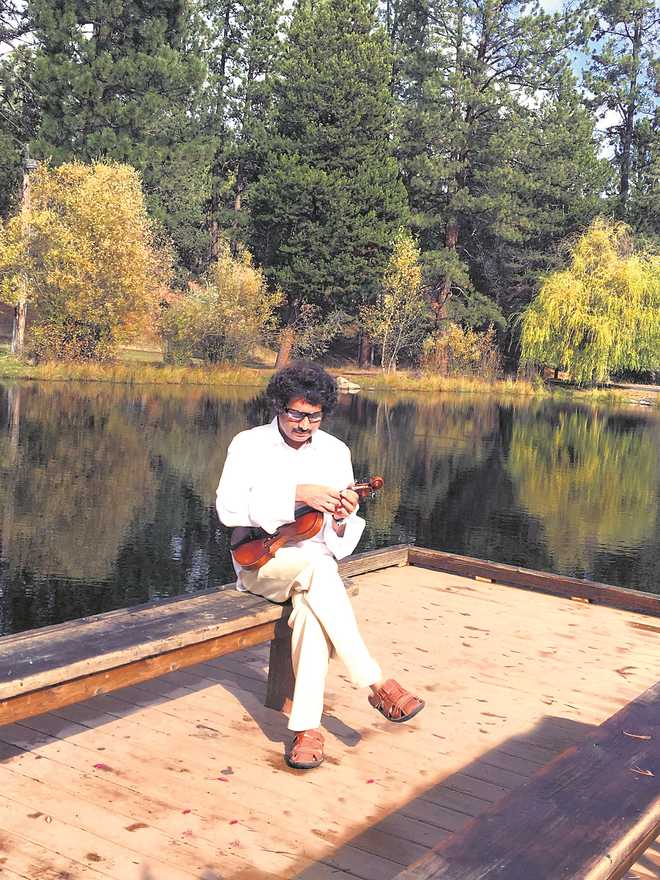
Mysore Manjunath, a renowned violinist
Shailaja Khanna
Renowned violinist, Sangeet Natak Akademi awardee Vidwan Mysore Manjunath once remarked that even Western composers thought of music in seasonal terms — Vivaldi’s Four Seasons, arguably the most well-known of his compositions, is one instance. Each of the distinguishing features of the four main seasons is represented through music; in his words “one can see autumn’s falling leaves, feel winter’s cold.”
It is a given that Indian classical music too, with its exquisite refinement, honed literally over centuries, had certain Ragas and compositions for six seasons — vasant ritu (spring), grishma ritu (summer), varsha ritu (monsoon), sharad ritu (autumn), hemant ritu (pre-winter), and shishir ritu (winter). Not only seasons, there are set time slots to render Ragas too; thus there are pre dawn, dawn, morning, afternoon, dusk, evening and night Ragas.
In the North Indian tradition, the three Ragas to be rendered specifically in spring are Basant, Bahar and Hindol. The six main Ragas, from which all other Ragas emanate, are associated with the time of the day, and/or the season. These are, Raga Bhairav (dawn), Raga Hindol (spring, morning), Raga Megh (monsoon), Raga Shri (dusk), Raga Deepak (evening), and Raga Malkauns (late night and, some say, winter).
Raga Basant and Bahar can be rendered any time during the vasant ritu. A popular innovation is a combination of the two — Raga Basant-Bahar; another more rare combination is Raga Hindol-Bahar. Around 40-50 years ago, artists usually rendered Raga Basant or Bahar in every concert held during February-March. Nowadays, sadly, this custom is not being followed; perhaps because we are so alienated from Nature in our urban settings.
Keeping tradition alive
Open air concerts in spring seem to have become popular perhaps around 200 years back. The tradition of having concerts on barges (bajra) on the river Ganga in Banaras is maintained to date. Here thumris, the popular, considered lighter genre of classical music, are sung from early evening till late night.
Some thumris are associated with different seasons. Thus, there are holis sung in the month of March, chaitis for the month of Chaitra or April, jhoolas and kajris for the monsoon in June/July and so on. Baarah maasi’s describe the mood of the 12 months musically. Sunanda Sharma, a renowned thumri exponent of the Banaras gharana, held these “are beautiful styles, and quite distinct in themselves”.
Today, it is generally not known what the prescribed Ragas of grishma ritu are. Padma Bhushan Pt Gokulotsav Maharaj, an erudite musician, in addition to having a priestly lineage, shared that there were Ragas for summer too, but nowadays no body follows traditions.
In the varsha ritu, the commonly rendered Ragas are all types of Malhars. In earlier texts, the original name of the Raga was “Mallar”; this was an adaptation of the parent Raga Megh, and a combination of both Ragas is rendered as Raga Megh-Malhar. Dr Shruti Sadolikar, Vice-Chancellor at the Bhatkhande University in Lucknow and a senior representative of the Jaipur Atrauli vocal tradition, explained the origin of the word “Malhar”. “Over time, Mal (dirt) harne wala (that which washed off the summer dust) came to be called Raga Malhar,” she said.
The Malhars, the music of the monsoon, has a greater significance than the other seasonal Ragas as the monsoon is so critical in the Indian context. The relief from the searing heat of summer is eagerly awaited and solicited; in the earlier times when there was no electricity, it was solely the rains that eased the physical distress caused by extreme heat. No wonder, over the centuries, there is an abundance of rain-related compositions. Dr Shruti Sadolikar is currently researching the Sanskrit works of Kalidas that describe the different types of rainfall, and setting these verses to music.
Different strokes of Malhar
Not only compositions, there are so many different types of Malhar. Some Malhars were composed by saint musicians like Surdas, Ramdas, Meera bai and Charju - Surdasi Malhar, Ramdasi Malhar, Meera Malhar and Charju Malhar. Some are combinations of other Ragas with Malhar — Nat-Malhar, Gaur- Malhar, Jayant- Malhar amongst others. Mostly all the lyrics deal with rain, raindrops, clouds, thunder, peacocks dancing et al.
The Carnatic tradition does not appear to have seasonal ragas, according to well known-scholar and musician Dr T S Sathyavathi. However, Raga Vasanta is definitely associated with spring, she said, and in the month of “marghazi” or December, it is traditional to sing Andal’s compositions. Muthuswamy Dikshitar’s composition varshaye varshaye in Raga Amritavarshini is universally accepted as having once brought rain. According to Mysore Manjunath and as the fable goes, it brought so much rain that the affected villagers had to implore the saint to sing something to take away the rain! It had not rained for five years in the region, and there was severe drought.
The ragas of sharad ritu, hemant ritu and shishir ritu seem to have passed into oblivion. Dr Viraj Amar, senior vocalist of the Banaras Gharana, who is also a scholarly musicologist, shared that the theory that Raga Shri is a pre-winter raga, and Raga Malkauns for deep winters, seems to a fable now. “Today, the raga theory holds more significance with the samay chakra or the time cycle, rather than the seasons,” she said.
One is eagerly awaiting the onset of the monsoon and the accompanying Malhar concerts.
Indian classical music, with its exquisite refinement, honed literally over centuries, had certain Ragas and compositions for six seasons — vasant ritu (spring), grishma ritu (summer), varsha ritu (monsoon), sharad ritu (autumn), hemant ritu (pre-winter), and shishir ritu (winter). Not only seasons, there are set time slots to render ragas too; thus there are pre-dawn, dawn, morning, afternoon, dusk, evening and night ragas. — Shruti Sadolikar



























